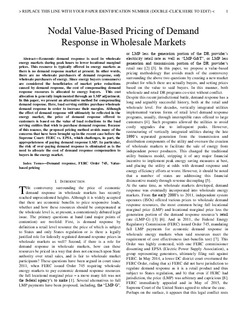Evaluating Optimal Cost-Effectiveness of Demand Response in Wholesale Markets
Journal article, Peer reviewed
Accepted version

Åpne
Permanent lenke
http://hdl.handle.net/11250/2596689Utgivelsesdato
2018Metadata
Vis full innførselSamlinger
Sammendrag
Economic demand response (DR) is intended to lower locational marginal prices (LMP) in wholesale energy markets during peak hours. DR resources are paid LMP and that cost is allocated to energy buyers. Market operators use a "net benefits test" to determine if DR is cost effective. This test identifies the LMP threshold below which DR is not cost effective; however, it cannot identify an optimal quantity of DR. Under the current net benefits test, acquisition of "all cost-effective DR" effectively results in a wealth transfer from generators to DR resources and LMPs that are no lower than without DR. Since DR, unlike energy, has no utility, this is not an ideal test of DR cost effectiveness. In this paper, we present a) an alternative method for evaluating the cost effectiveness of economic DR in wholesale markets that makes use of unique DR supply and demand curves, and b) an alternative welfare analysis methodology that identifies maximum social welfare (optimal quantity of DR). We find that because DR has no utility beyond lowering market prices, the optimal quantity of DR does not occur at market equilibrium. Rather, it occurs at the point where potential financial gain from DR is equal to dead weight losses.